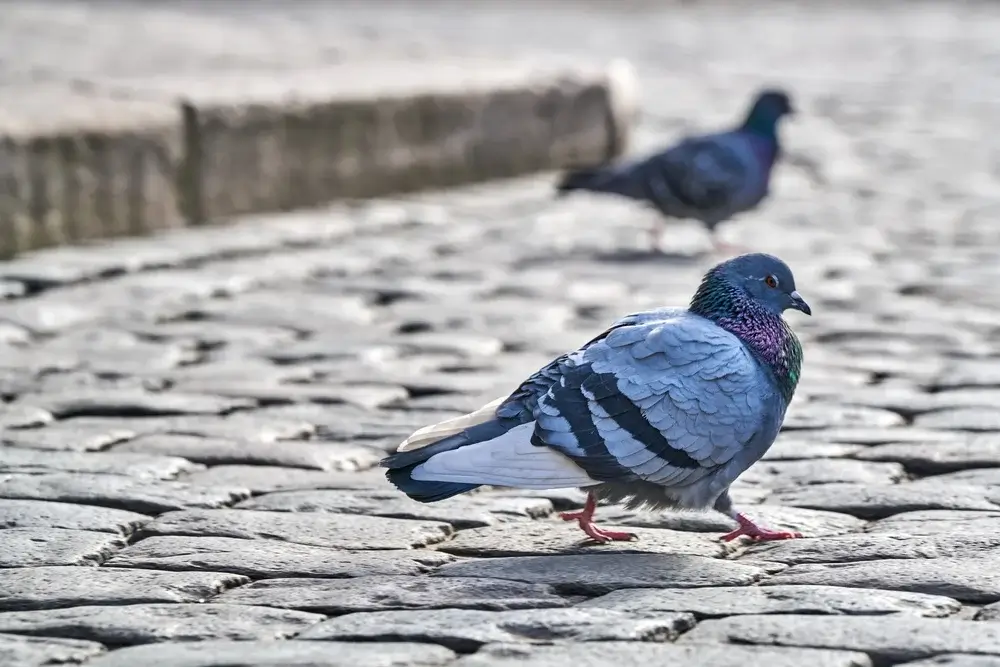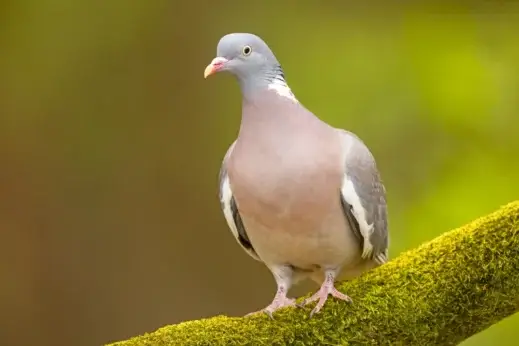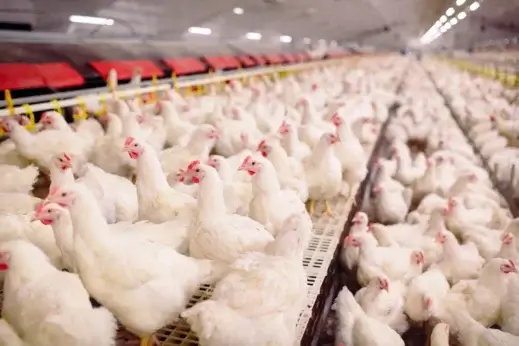Rats With Wings, Vaccines, And New Breed—2024’s Solutions to the Bird Flu Crisis
Bird flu has held the poultry industry in its clutches since 2022. If the industry won’t change, the consumers will.
Rats With Wings, Vaccines, And New Breed—2024’s Solutions to the Bird Flu Crisis
Bird flu has held the poultry industry in its clutches since 2022. If the industry won’t change, the consumers will.

by Shutterstock
Bird flu has held the world’s poultry industry in its unrelenting clutches before, causing catastrophic losses of more than 50 million birds in 2015. After a brief break, where we were lulled into a sense of false security, it came back in full force in 2022. Even now in 2024, we haven’t yet curbed bird flu’s deadly spread—but those passionate about wildlife and disease prevention are doing their part to intervene and, hopefully, slow our many tragic losses of wild and domestic animals.
But the fight with bird flu isn’t over yet, and we may come out on the other side with healthier birds (and new menu options).

Rats with wings
The humble pigeon, thought by many to be a pest, has much to offer us in this fight against bird flu. Pigeons were once revered as war heroes, used to carry messages during the world wars; the Dickin Medal, the highest possible decoration for valor in animals, has been given to 32 pigeons, beginning with Winkie the pigeon in 1942. Before that, we used pigeons for meat and eggs, and squab (juvenile pigeons) remain a delicacy in much of the world. Texts from Spain regarding raising pigeons for their meat date back as far as 60 A.D.
But today, it’s the pigeons’ DNA that can help us. Pigeons have high numbers of interferon-stimulated genes (which signal to infected cells when a pathogen is present), giving them what researchers hypothesize is an inherent ability to prevent viruses from entering their cells and spreading. After being exposed to bird flu in a lab environment, pigeons showed a low immune response and had low levels of the virus in their bodies. In comparison, chickens and turkeys with the same exposure had high levels of the virus concentrated in their organs, particularly in the brain.
Further studies have shown pigeons to be resistant and/or minimally susceptible to the virus. One hundred rock pigeons were tested for the virus during the 2022 outbreak; only two were positive. However, their deaths were not attributed to the virus.
Obviously, the poultry industry’s showing no signs of restructuring to push pigeon quesadillas or pigeon tenders as your weeknight dinner. Despite pigeons’ benefits in bird flu resistance, much of our industry is focused around the more traditional chicken and turkey. But for those in favor of pigeon, they claim to reap the benefits.
Squab Producers of California, founded in 1943, is the largest squab producer in the US, producing more than 400,000 squab yearly. Although SPOC owns a commercial processing plant, the squab are raised in more than 600 different local farms that work together as a co-op, so that the birds don’t have to face the traditional factory farming environment.
The federation’s president, Dalton Rasmussen, notes that the birds produce better when they’re happier—so they try to give each bird a short but sweet life. The birds processed by SPOC spend their short time in small, locally owned farms, often with outdoor flight pens that allow older breeder birds a taste of the good life. “It’s one of the tastiest, tenderest meats that you can get,” says Rasmussen. “It used to be known as the meat of kings, because it was served to royalty all the way back to the Egyptian days.”
Prices for conventional chicken and turkey meat, as well as eggs, have suffered through the bird flu epidemic. In addition, fear associated with the virus has dampened consumers’ enthusiasm for poultry dinners. Tyson, one of the largest poultry producers in the US, reported slipping sales through 2023, leading to the closure of four of its plants. US poultry sales overall declined by 13 percent between 2022 and 2023. It’s hard to say whether it’s impacted squab farmers, with so few commercial farmers to reference, but, so far, there has yet to be a bird flu breakout at any US pigeon farming facility. In an uncertain time of H5N1, we may see more consumers trying pigeon. And with many neighborhoods restricting chicken ownership, maybe we’ll see backyard pigeon roosts gaining in popularity, too.
We can’t change Bird Flu. Can we change chickens?
There are some possible pigeon-less solutions in the works, such as gene editing. However, it’s a tricky business, and it rarely has a guaranteed payoff.
Scout Thompson, a PhD student in biology at Western University, says the technology might not yet be sophisticated enough to prevent the spread of avian flu. “Even if [gene editing] could successfully eradicate the current strains of concern in domestic flocks, the virus could still persist in wild waterfowl and be reintroduced with mutations.”
And, with the current state of bird flu infections, that possibility doesn’t seem unlikely. Many different species of waterfowl have already fallen victim, and experts are concerned that migratory patterns of waterfowl may cause seasonal surges in infection. Researchers have begun making progress with the CRISPR gene-editing technique, but we simply don’t yet know if this could result in long-term progress for the battle against H5N1.

Betting on biosecurity
Vaccines are always an option, but it’s not always possible to mass-vaccinate poultry on the scale that would be required on a factory farm; after a positive test, just one major poultry farm in Texas was forced to cull close to two million chickens.
But for smaller flocks, vaccines can be a source of hope. “I think we should make it easier for very small flocks to purchase vaccinations, medications and other treatments for their birds,” says Saro Nortrup, an urban flock owner in Nebraska. “Most of these, such as [medication for] Marek’s disease, are very expensive with large dosage options and a very limited shelf life.”
According to the Rare Breeds Survival Trust, all of the UK’s native breeds of chickens, ducks and geese are under threat from bird flu. While bird flu losses that make the news typically number in the millions, Nortrup noted that any bird’s death can cause a cascade of damage. “If you have a rare breed, for example, the loss of your flock could have a serious impact on the genetic pool of an entire breed.”
Many American producers grew frustrated as it seemed to be an endless wait for bird flu vaccinations that weren’t coming; even now, many farms don’t have access to preventative vaccines. However, renewed interest has led to new developments and increased accessibility for these vaccines; scientists are working on a vaccine for humans, in the case of a potential pandemic if bird flu begins inter-human transmission.
We don’t have all the answers to bird flu yet. But, with so many partial solutions in the works, we’ll find a way to push forward—even if the poultry industry is never quite the same.
Correction: A previous version of this article referred to HPAI as H1N1. That has been corrected to H5N1.
Follow us
This work is licensed under a Creative Commons Attribution-NoDerivatives 4.0 International License.
Want to republish a Modern Farmer story?
We are happy for Modern Farmer stories to be shared, and encourage you to republish our articles for your audience. When doing so, we ask that you follow these guidelines:
Please credit us and our writers
For the author byline, please use “Author Name, Modern Farmer.” At the top of our stories, if on the web, please include this text and link: “This story was originally published by Modern Farmer.”
Please make sure to include a link back to either our home page or the article URL.
At the bottom of the story, please include the following text:
“Modern Farmer is a nonprofit initiative dedicated to raising awareness and catalyzing action at the intersection of food, agriculture, and society. Read more at <link>Modern Farmer</link>.”
Use our widget
We’d like to be able to track our stories, so we ask that if you republish our content, you do so using our widget (located on the left hand side of the article). The HTML code has a built-in tracker that tells us the data and domain where the story was published, as well as view counts.
Check the image requirements
It’s your responsibility to confirm you're licensed to republish images in our articles. Some images, such as those from commercial providers, don't allow their images to be republished without permission or payment. Copyright terms are generally listed in the image caption and attribution. You are welcome to omit our images or substitute with your own. Charts and interactive graphics follow the same rules.
Don’t change too much. Or, ask us first.
Articles must be republished in their entirety. It’s okay to change references to time (“today” to “yesterday”) or location (“Iowa City, IA” to “here”). But please keep everything else the same.
If you feel strongly that a more material edit needs to be made, get in touch with us at [email protected]. We’re happy to discuss it with the original author, but we must have prior approval for changes before publication.
Special cases
Extracts. You may run the first few lines or paragraphs of the article and then say: “Read the full article at Modern Farmer” with a link back to the original article.
Quotes. You may quote authors provided you include a link back to the article URL.
Translations. These require writer approval. To inquire about translation of a Modern Farmer article, contact us at [email protected]
Signed consent / copyright release forms. These are not required, provided you are following these guidelines.
Print. Articles can be republished in print under these same rules, with the exception that you do not need to include the links.
Tag us
When sharing the story on social media, please tag us using the following: - Twitter (@ModFarm) - Facebook (@ModernFarmerMedia) - Instagram (@modfarm)
Use our content respectfully
Modern Farmer is a nonprofit and as such we share our content for free and in good faith in order to reach new audiences. Respectfully,
No selling ads against our stories. It’s okay to put our stories on pages with ads.
Don’t republish our material wholesale, or automatically; you need to select stories to be republished individually.
You have no rights to sell, license, syndicate, or otherwise represent yourself as the authorized owner of our material to any third parties. This means that you cannot actively publish or submit our work for syndication to third party platforms or apps like Apple News or Google News. We understand that publishers cannot fully control when certain third parties automatically summarize or crawl content from publishers’ own sites.
Keep in touch
We want to hear from you if you love Modern Farmer content, have a collaboration idea, or anything else to share. As a nonprofit outlet, we work in service of our community and are always open to comments, feedback, and ideas. Contact us at [email protected].by Patrick Kuklinski, Modern Farmer
July 4, 2024
Modern Farmer Weekly
Solutions Hub
Innovations, ideas and inspiration. Actionable solutions for a resilient food system.
ExploreShare With Us
We want to hear from Modern Farmer readers who have thoughtful commentary, actionable solutions, or helpful ideas to share.
SubmitNecessary cookies are absolutely essential for the website to function properly. This category only includes cookies that ensures basic functionalities and security features of the website. These cookies do not store any personal information.
Any cookies that may not be particularly necessary for the website to function and are used specifically to collect user personal data via analytics, ads, other embedded contents are termed as non-necessary cookies.
It’s been a personal joy to see the cultural shift in how Americans see and treat pigeons. I hope to see better treatment for all of our domestic birds, but also the humble feral pigeon that we’ve neglected for too long.
Author: name that virus properly: H5N1 is the bird flu. Also, please be aware that Gain of Function research has been going on for years now on this same virus. Can’t be good, right?
And, be aware that the culling has failed miserably, while killing millions of non-affected birds. Read more from Joel Salatin, a modern farmer with a sound head on his shoulders: https://brownstone.org/articles/why-are-the-chickens-so-sick/